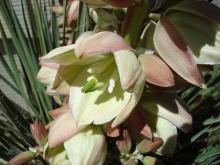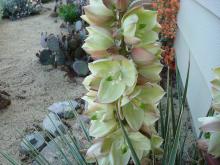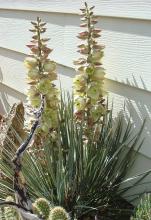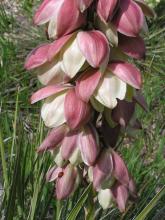The hardiest of the hardy Yuccas and the most wide spread.
I grew up seeing Y. Glauca on the short grass prairies of North and South Dakota. Most of the time the flowers are white blushed with pink. I have never come across any with darker pink flowers. Years ago I was reading in Claude A. Barr's 'Jewels of the Plains' that he was searching for some.(Is my poor memory correct?)
If so are any of the descendants of his selections around?
Comments
Re: Yucca glauca
What a fine flowering plant that is in John's garden! Yuccas grow well here but we just don't have the right setting for them, although maybe more gardeners might create mini-deserts in their gardens - there are a few parts of the south-east where rainfall drops below 20" annually, and gardens like Beth Chatto's with almost pure sand and gravel as a substrate.
Re: Yucca glauca
That would be a resounding No.
As you're probably aware, most gardeners in this region want their gardens to look like eastern gardens, with daylilies and hostas and roses.
Bob
Bob
I figured as much. :-[
Same out here in the far west. Oh and for goodness sake don't forget to keep your blue grass lawn green. But things are slow to change, all I can do is show off my little slice of heaven to whoever is interested! ;)
Aaron
That is a grand old Yucca! I'll bet it demands respect when you encroach on it's personal space. :)
Tim
Thank you.
Re: Yucca glauca
Aaron
That is a grand old Yucca! I'll bet it demands respect when you encroach on it's personal space. :)
Just about 16-17 years old, one of the first yuccas I plantyed here. :)
Re: Yucca glauca
Your slice of heaven looks very nice.
Same out here in the far west. Oh and for goodness sake don't forget to keep your blue grass lawn green.
There are reasons for this. When xeriscape was first introduced, the idea (at least as presented at DBG) was a plant-for-plant replacement of water-loving plants with native dryland plants.
It has evolved into something quite different.
Bob
Re: Yucca glauca
Why do we ever strive to get a garden at all with plants not naturally belonging to the landscape ;D
For example, why should I want to grow Yuccas in my garden - creating a lot of work and trouble for myself! It is unbelievable - but very fun ;D ;D
Re: Yucca glauca
Why do we ever strive to get a garden at all with plants not naturally belonging to the landscape ;D
For example, why should I want to grow Yuccas in my garden - creating a lot of work and trouble for myself! It is unbelievable - but very fun ;D ;D
Because we are eternal optimists. ;D
Re: Yucca glauca
I enjoyed reading Barr's description of his search for colorful forms of Yucca glauca. I concur with John that most individuals are cream, sometimes with a blush of pink. Yet some redder ones are still evident e.g., this individual in a roadcut along Highway 14 above Sheridan, Wyoming. One problem in developing good color forms, at least from seed, is that it requires the patience of Job. Eight years ago I germinated a nice batch, and I am still waiting for the first flowering stem from the several survivors.
Re: Yucca glauca
Michael
That is a very nice form. The best I've seen and I've seen quite a few! Maybe you'll get blossoms on your's this year. Got my fingers crossed that they bloom and that you get a pink one. :D
Re: Yucca glauca
Alas, those I am growing were collected during a roadside stop in February near Billings, Montana. I suspect they will throw the typical cream blossoms, but those will be welcome regardless.
Re: Yucca glauca
Your no doubt right about the color.
Have you ever tried to move a Y. glauca in from the wild? I have on several occasions dug smaller specimens with very good results.
They have a very long tap root but you don't necessarily need to get all of it. A foot or two of it will normally be enough, especially if you dig it in early spring. The roots you leave in the ground will often resprout. I have even had the crown rot off of one. It come back from the dead by the end of the summer and is a fine specimen now. I'm wondering if a person could take a root cutting form secondary lateral roots and use them for propagation.
Re: Yucca glauca
So John, did the roots left sprout in multiplicity, or just one sprout per group of roots?
Was there a difference between dug plants and the one who's crown rotted?
Re: Yucca glauca
Some times there are a couple of new crowns not very far apart. I imagine were a few of the larger roots were severed.
The rotted plant came back as two crowns right were it had rotted, so I think laten buds on the good portion of the tap root took over.
Re: Yucca glauca
The only advice I have ever heard regarding root physiology for cuttings is a size consideration. I have never heard it mentioned, for example, that the actual taproot might be better for cuttings than the laterals, given equal girth. Purely based on this, it would seem that latteral root cutting propagation of at least this species of yucca would be successful.
I would have thought that someone would have tried it by now, though.
Maybe someone out there has...?
Re: Yucca glauca
I think excavating a plant can be done without lasting damage. I've certainly done so with another species of yucca--Y. baccata, I think--and it responded as John suggested: I now have two very large specimens in separate parts of the garden.
Re: Yucca glauca
By the way, Michael, that is a drop-dead gorgeous avatar photo. I don't want to veer from the Yucca topic too much, but what is it?
Re: Yucca glauca
It is Castilleja scabrida, taken on 28 April last year in a canyon that is tributary to the Escalante River between Boulder and Escalante, Utah. I've not (yet!) attempted to grow it, because I lack hectares of sandstone.






That would be a resounding No. Except for Aster 'Dream of Beauty' and some cactus, everything is gone, though I like to think that there are gardens somewhere, where his selections are growing, unlabeled and forgotten.
As you're probably aware, most gardeners in this region want their gardens to look like eastern gardens, with daylilies and hostas and roses.
Bob